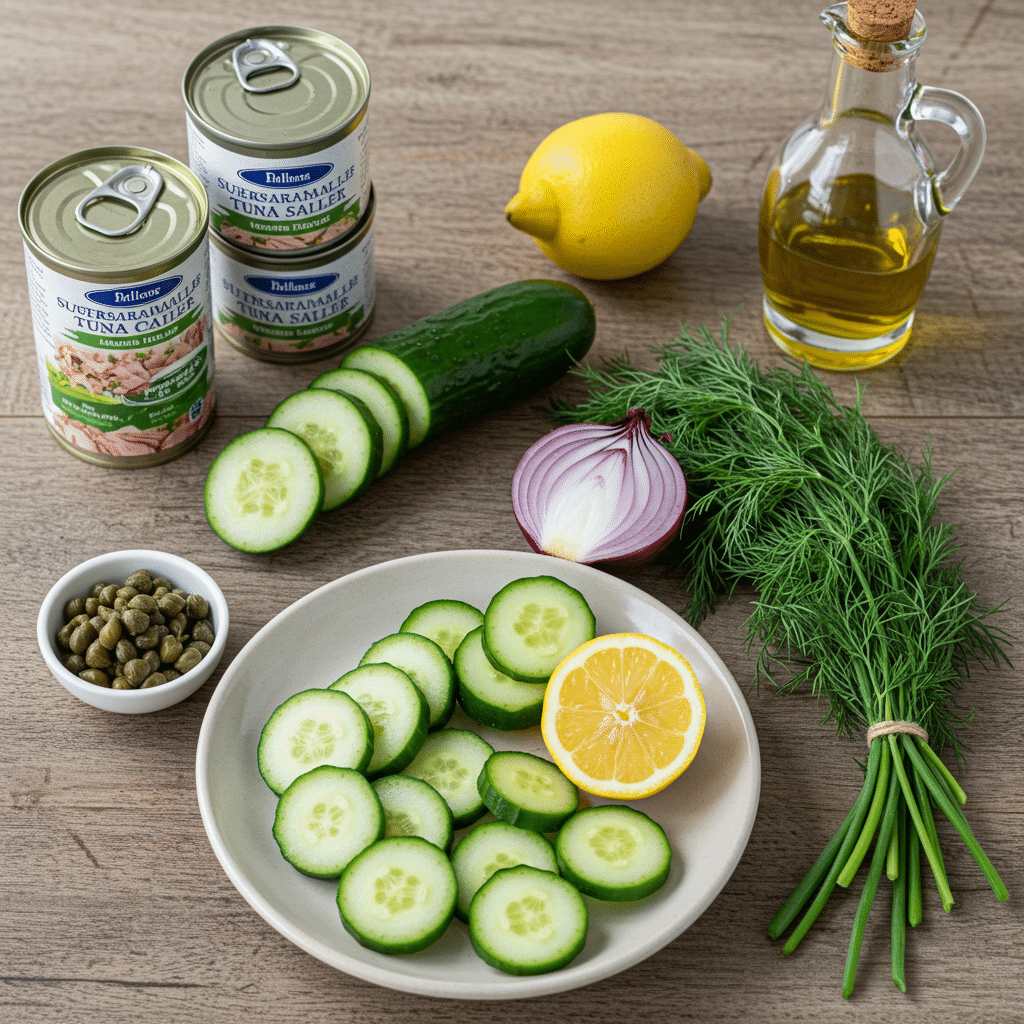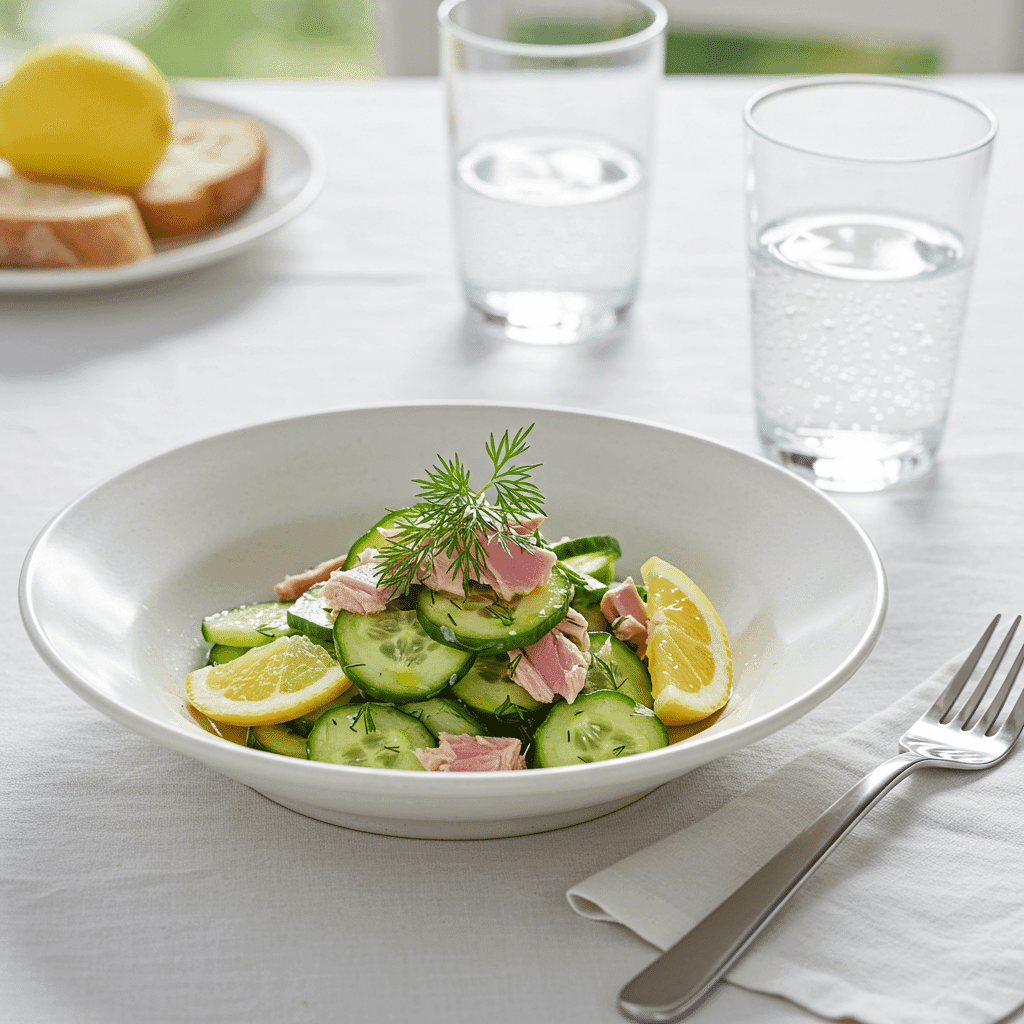The growing awareness of ocean conservation has transformed how conscious consumers approach seafood choices, particularly when preparing beloved classics like tuna cucumber salad. This sustainable tuna cucumber salad recipe not only delivers the fresh, protein-rich meal you crave but also ensures your dining choices support healthy marine ecosystems and ethical fishing practices.
With global tuna populations facing significant pressure from overfishing, choosing sustainably sourced tuna has become more critical than ever. This comprehensive guide will show you how to create a delicious, nutritious tuna cucumber salad while making environmentally responsible choices that protect our oceans for future generations.
As a certified sustainable seafood advocate with over a decade of experience in marine conservation and culinary nutrition, I’ll share evidence-based insights on selecting the best sustainable tuna options and crafting the perfect cucumber salad that satisfies both your taste buds and environmental values.
Table of Contents
Understanding Sustainable Tuna: Why It Matters
The Current State of Global Tuna Populations
According to the International Seafood Sustainability Foundation (ISSF), several tuna species face varying degrees of population pressure. Bluefin tuna populations have declined by over 85% from historic levels, while yellowfin and bigeye tuna stocks show concerning trends in certain regions. However, skipjack tuna, commonly used in canned varieties, remains relatively stable when harvested using responsible methods.
What Makes Tuna Sustainable?
Sustainable tuna fishing practices focus on three key principles:
Fishing Method Impact: Pole-and-line caught tuna and purse seine methods without fish aggregating devices (FADs) significantly reduce bycatch of dolphins, sharks, and sea turtles. These methods result in up to 95% fewer marine casualties compared to longline fishing.
Stock Management: Sustainable fisheries operate within scientifically determined quotas, ensuring tuna populations can reproduce and maintain healthy numbers. The Marine Stewardship Council (MSC) certification requires fisheries to demonstrate that their catch levels allow for long-term sustainability.
Traceability and Transparency: Responsible tuna brands provide clear information about their supply chain, fishing locations, and vessel practices. This transparency allows consumers to make informed choices about their seafood purchases.
Top Sustainable Tuna Brands for Your Cucumber Salad
Premium Sustainable Options
Safe Catch Elite Wild Tuna leads the market in both sustainability and purity standards. Their pole-and-line caught tuna contains the lowest mercury levels of any brand tested, with mercury levels averaging 10 times lower than FDA limits. The company sources from MSC-certified fisheries and provides detailed vessel information for complete traceability.
Wild Planet Albacore and Skipjack Tuna offers another excellent sustainable choice. Their tuna is caught using traditional pole-and-line methods by American fishermen, and the company maintains strict standards for both environmental impact and worker conditions. Wild Planet’s albacore contains higher omega-3 fatty acids compared to conventional brands.
Ortiz Anchovies and Tuna from Spain represents premium European sustainable fishing. Their yellowfin tuna is line-caught in the Pacific and Atlantic oceans, with no use of purse seines or nets. While more expensive, Ortiz tuna offers superior flavor and texture for gourmet preparations.
Budget-Friendly Sustainable Choices
Kirkland Signature Albacore (Costco’s brand) sources from MSC-certified fisheries at a fraction of premium brand costs. Independent testing confirms their sustainability claims and mercury levels remain well within safe limits.
Great Value Chunk Light Tuna (Walmart) has improved their sourcing practices significantly, now offering FAD-free skipjack tuna options. While not as comprehensive in their sustainability reporting as premium brands, they represent an accessible entry point for budget-conscious consumers.
The Perfect Sustainable Tuna Cucumber Salad Recipe
Ingredients (Serves 4)
For the Salad:
- 2 cans (5 oz each) sustainable tuna in water, drained
- 2 large English cucumbers, thinly sliced
- 1 small red onion, thinly sliced
- 1/4 cup fresh dill, chopped
- 2 tablespoons capers, drained
- 1/4 cup sun-dried tomatoes, chopped (optional)
For the Dressing:
- 3 tablespoons extra-virgin olive oil
- 2 tablespoons fresh lemon juice
- 1 tablespoon
- 1 teaspoon Dijon mustard
- 1 clove garlic, minced
- Salt and freshly ground black pepper to taste

Step-by-Step Preparation
Prep the Cucumbers (5 minutes): Using a mandoline slicer or sharp knife, cut cucumbers into thin, uniform slices approximately 1/8-inch thick. Place in a colander, sprinkle with salt, and let drain for 10 minutes to remove excess moisture. This crucial step prevents a watery salad.
Prepare the Dressing (3 minutes): In a small bowl, whisk together olive oil, lemon juice, Dijon mustard, and minced garlic until emulsified. Season with salt and pepper. The acid in the lemon juice will help preserve the cucumber’s crispness.
Assemble the Salad (7 minutes): Pat cucumbers dry with paper towels. In a large serving bowl, gently combine the sustainable tuna, prepared cucumbers, red onion slices, fresh dill, and capers. Pour the dressing over the mixture and toss gently to coat all ingredients evenly.
Final Touches: Allow the salad to marinate for 15-20 minutes at room temperature before serving. This resting period allows the flavors to meld while maintaining the cucumber’s crisp texture.
Nutritional Benefits and Health Considerations
Protein Powerhouse Profile
A single serving of this sustainable tuna cucumber salad provides approximately 25 grams of high-quality complete protein, containing all nine essential amino acids. The protein content supports muscle maintenance, satiety, and metabolic function, making this salad an excellent choice for active individuals and those managing weight.
Omega-3 Fatty Acid Content
Sustainable tuna varieties, particularly albacore, contain significant amounts of EPA and DHA omega-3 fatty acids. Research published in the American Journal of Clinical Nutrition indicates that regular consumption of these fatty acids supports cardiovascular health, brain function, and may reduce inflammation markers by up to 20%.
Micronutrient Density
Cucumbers contribute essential nutrients often overlooked in their nutritional profile. They provide vitamin K for bone health, potassium for blood pressure regulation, and silica for skin and hair health. The combination of tuna and cucumber creates a synergistic nutrient profile that supports overall wellness.
Mercury Considerations
When choosing sustainable tuna, mercury content varies significantly between species and brands. Skipjack tuna (commonly found in “chunk light” varieties) contains approximately 0.12 parts per million of mercury, while albacore averages 0.32 ppm. The FDA considers both levels safe for regular consumption, but pregnant women should limit albacore intake to 6 ounces per week.
Environmental Impact: Your Salad’s Ocean Footprint
Carbon Footprint Comparison
Choosing sustainable tuna can reduce your meal’s carbon footprint by up to 40% compared to conventional options. Pole-and-line fishing methods use significantly less fuel than industrial longline operations, as vessels can fish closer to shore and with shorter trip durations.
Bycatch Reduction Benefits
Traditional tuna fishing methods result in approximately 10 pounds of bycatch for every pound of tuna caught. Sustainable fishing practices reduce this ratio to less than 1 pound of bycatch per pound of target species, protecting dolphins, sea turtles, sharks, and other marine life.
Supporting Fishing Communities
Purchasing sustainably caught tuna directly supports small-scale fishing operations and coastal communities. These fisheries typically employ more people per pound of fish caught and contribute more economic value to local economies compared to industrial fishing operations.
Storage and Food Safety Guidelines
Proper Storage Techniques
Fresh tuna cucumber salad should be consumed within 24 hours of preparation when stored in the refrigerator at 40°F or below. The combination of acidic dressing and fresh vegetables creates an environment that inhibits bacterial growth, but the salad should never be left at room temperature for more than 2 hours.
Meal Prep Considerations
For meal preparation purposes, store the dressed salad components separately from fresh cucumbers until serving. The tuna mixture can be prepared up to 3 days in advance, while cucumbers should be sliced and dressed no more than 4 hours before consumption to maintain optimal texture.
Quality Indicators
Fresh, properly stored tuna cucumber salad should maintain its crisp texture and bright flavors. Discard the salad if you notice any slimy texture on cucumbers, off-odors, or significant separation of the dressing components.
Seasonal Variations and Customization Ideas
Summer Enhancement Options
During peak cucumber season (June through August), experiment with heirloom cucumber varieties like Armenian or lemon cucumbers for unique flavors and textures. Add fresh herbs such as mint, basil, or parsley to complement the seasonal produce.
Mediterranean-Inspired Variations
Transform your sustainable tuna cucumber salad into a Mediterranean feast by incorporating Kalamata olives, cherry tomatoes, and feta cheese. This variation increases the salad’s calcium content while adding complex flavors that pair beautifully with sustainable tuna.
Asian-Fusion Adaptations
Create an Asian-inspired version using rice vinegar, sesame oil, and fresh ginger in the dressing. Add edamame, shredded carrots, and sesame seeds for additional texture and nutritional value. This preparation method works particularly well with sustainably caught yellowfin tuna.
Pairing Suggestions and Serving Ideas
Complementary Grain Options
Serve your sustainable tuna cucumber salad over quinoa, farro, or brown rice for a more substantial meal. These whole grains add fiber, B-vitamins, and additional plant-based protein to create a complete, satisfying dish that supports sustained energy levels.
Beverage Pairings
The fresh, clean flavors of this salad pair excellently such as Sauvignon Blanc or Pinot Grigio. For non-alcoholic options, sparkling water with lemon or cucumber-infused water enhances the salad’s refreshing qualities.

Make-Ahead Party Platters
This recipe scales beautifully for entertaining, making it perfect for summer gatherings, picnics, or potluck events. When serving larger groups, prepare the salad in a shallow, wide bowl to showcase the colorful ingredients and facilitate easy serving.
Cost Analysis: Sustainable vs. Conventional Tuna
Initial Investment Comparison
Sustainable tuna typically costs 20-50% more than conventional options, with premium brands like Safe Catch and Wild Planet ranging from $3-5 per can compared to $1-2 for conventional varieties. However, the superior quality, flavor, and nutritional value often justify the additional expense.
Long-term Value Considerations
When factoring in the enhanced nutritional profile, lower mercury content, and positive environmental impact, sustainable tuna provides significant long-term value. The higher protein density and omega-3 content can reduce the need for additional supplements, offsetting some of the initial cost difference.
Budget-Friendly Sustainable Strategies
Purchase sustainable tuna in bulk during sales, store-brand sustainable options, or consider mixing sustainable tuna with other protein sources like chickpeas or white beans to extend the serving size while maintaining nutritional benefits.
Frequently Asked Questions
Is canned tuna as nutritious as fresh tuna?
Canned tuna retains most of its nutritional value during processing, with protein content remaining virtually unchanged. However, some water-soluble vitamins may be reduced during canning. Sustainable canned tuna often undergoes minimal processing, preserving more nutrients than conventional varieties.
How often can I safely eat tuna cucumber salad?
The FDA recommends 2-3 servings of fish per week for optimal health benefits. Given the lower mercury levels in sustainable tuna brands, you can safely enjoy this salad 2-3 times per week as part of a balanced diet.
Can I substitute other sustainable fish in this recipe?
Absolutely! Wild-caught salmon, sardines, or mackerel work excellently in this preparation. Each offers unique nutritional benefits and flavors while maintaining the sustainable seafood focus.
What’s the best way to identify truly sustainable tuna?
Look for third-party certifications such as MSC (Marine Stewardship Council), Dolphin Safe labels, and specific information about fishing methods. Brands that provide detailed sourcing information and vessel tracking typically demonstrate genuine commitment to sustainability.
Conclusion
Creating a delicious sustainable tuna cucumber salad represents more than just preparing a healthy meal—it’s an act of environmental stewardship that supports marine conservation while nourishing your body with premium nutrients. By choosing sustainably sourced tuna, you contribute to fishing practices that protect ocean ecosystems and ensure tuna populations remain viable for future generations.
This recipe demonstrates that making environmentally conscious food choices doesn’t require sacrificing flavor, convenience, or nutritional value. The combination of sustainably caught tuna with fresh, crisp cucumbers creates a satisfying meal that aligns with both health goals and environmental values.
As you continue exploring sustainable seafood options, remember that every purchase represents a vote for responsible fishing practices. Your commitment to choosing sustainable tuna cucumber salad ingredients makes a meaningful difference in ocean conservation efforts while providing your family with exceptional nutrition and taste.